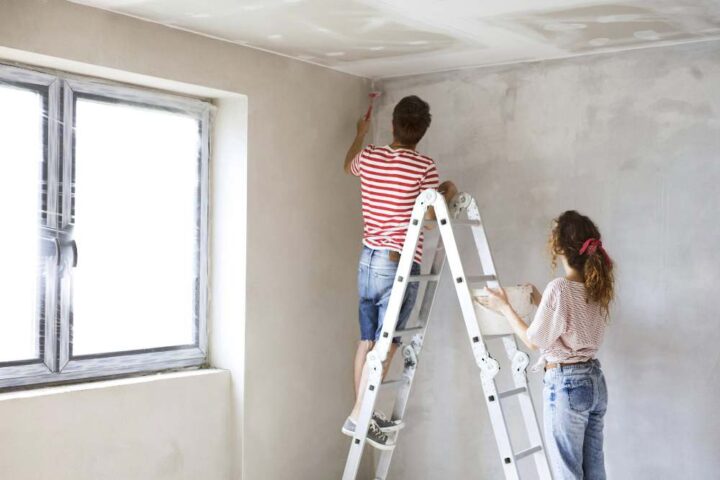Painting Mistakes You’ll Never See with the Pros
Ever started painting a wall and halfway through thought… this looks worse than before?
It happens more than most people admit. Painting might seem straightforward, but there’s a real difference between a DIY job and the kind of finish a professional delivers. And no, it’s not just about the tools or experience. It’s about avoiding the simple, easy-to-miss mistakes that quietly ruin the final result.
Let’s walk through the most common painting mistakes – the kind you’ll never catch a pro making – and how to avoid them yourself.

Skipping the prep
This is the number one sin of home painters. Experts like those at Perth Professional Painters would never pick up a roller until the surface is absolutely ready. Walls need to be cleaned. Not just a casual wipe, but a proper clean to remove dust, oils, and any residue that will mess with paint adhesion. Holes need to be filled, dents smoothed out, and everything sanded for an even finish. If there’s old flaky paint, it needs to go.
Painting over problems doesn’t hide them. It highlights them.
Forgetting to tape like you mean it
Proper painters treat taping seriously. They don’t just slap on some masking tape and hope for the best. They press it down fully, check for air bubbles, and run their fingers along the edge to seal it.
Not taping properly leads to messy edges and paint bleeding under the tape. It takes a little time upfront, but it saves hours of cleanup later, and the result is a sharp, crisp line every time.
Using cheap brushes and rollers
A pro wouldn’t touch a plastic-handled brush from a dollar shop. Quality applicators matter. They hold paint better, distribute it more evenly, and give you a smoother, cleaner finish.
Cheap rollers shed lint. Poor brushes leave streaks. That might seem minor until the wall dries and every flaw is suddenly more obvious than the colour itself.
Skipping the primer
Many people assume if the paint says it’s “paint and primer in one,” that’s enough. But ask any pro – that label doesn’t replace the value of a proper primer coat when it’s needed.
Primer helps with adhesion, evens out surface porosity, and gives you a better, truer colour result. It’s especially important when painting over dark colours, patchy repairs, or fresh plaster.
If you’re painting over something glossy, bare timber, or a stained surface, skipping primer is basically asking for trouble.
Painting in the wrong conditions
Professional painters always pay attention to the weather and room conditions. Paint behaves differently depending on temperature and humidity. If it’s too cold, paint can go on thick and not dry properly. Too hot, and it can dry too fast, leaving brush marks and lap lines. Too humid, and it may never fully cure.
They also know to avoid painting in direct sunlight, which causes paint to dry unevenly. The result? Patchy walls that reflect light weirdly.
Overloading the brush or roller
Thick, heavy coats might feel like they’re saving time. They’re not. Pros know that thin, even coats give a far better finish. When you overload a roller, paint drips down the wall, splatters across the floor, and leaves behind a texture that feels more like sandpaper than smooth paint.
The right technique? Dip only a third of the brush into the paint, tap off the excess, and apply in smooth strokes. For rollers, evenly load the roller and roll off the excess on the tray’s ridges.
Not maintaining a wet edge
One of the most obvious signs of an amateur paint job? Lap marks. These are the visible lines where sections of paint overlap but have dried unevenly. They happen when someone paints in patches instead of keeping a continuous edge.
A pro painter always maintains a wet edge, which means working in sections and rolling over the previous stroke while it’s still wet. It might sound technical, but it’s just about keeping your pace steady and working smart across the surface.
Poor cutting-in technique
Cutting in is the process of painting along edges and corners with a brush, and it makes or breaks the final look.
You’ll never see a pro leaving wobbly, uneven lines around the ceiling or trim. They take their time, use the right angle brush, and apply steady pressure for control.
Rushing through this step or relying too much on tape without technique creates a jarring edge that draws the eye, not in a good way.
Not allowing proper drying time
Paint needs time. That’s not just for drying, but curing too. Touch-dry isn’t fully dry. If you rush a second coat before the first is ready, you can get peeling, bubbling, or visible roller marks. Pros are strict about waiting the correct time between coats, and they read the tin, because drying time varies between products.
The same goes for putting furniture back or hanging things on the wall. If the paint hasn’t cured properly, anything pressing against it can leave marks or even pull paint off.
Rushing the clean-up
Here’s where things often fall apart. Once the last coat is on, many people throw the tools in a bucket, pull the tape too early, and walk away.
Pros treat cleanup as part of the job. They know when to remove tape (usually while the paint is still slightly wet to get the cleanest line), how to properly wash brushes so they last, and how to tidy up without damaging the paint job they’ve just finished.
Skipping this step leaves you with frayed brushes, hardened rollers, and messes you’ll notice days later.
What You Really Get with a Professional Finish
It’s not just about skill. It’s about consistency, patience, and avoiding shortcuts. A professional painter doesn’t rush, doesn’t guess, and definitely doesn’t wing it.
They know the surface, understand the paint, and work with purpose from start to finish.


